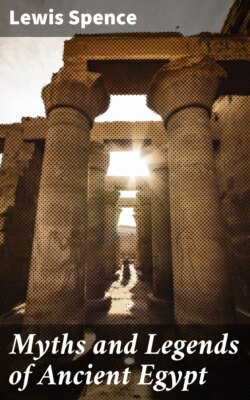Читать книгу Myths and Legends of Ancient Egypt - Lewis Spence - Страница 10
На сайте Литреса книга снята с продажи.
The 'Companies' of the Gods
ОглавлениеIn the Pyramid Texts we find frequent mention of several groups consisting of nine gods each. One of these companies of gods, or Enneads, was called the Great and another the Little, and the nine gods of Horus are also alluded to. It is not known, however, whether this group is in any way connected with either of the others. We also read in the Pyramid Texts of Teta of a double group of eighteen gods which recur in the text of Pepi I. These eighteen gods may simply be the Great and Little companies of gods taken together. In the texts of Pepi I and Teta, however, we find a third company of nine gods, officially recognized by the priests of Heliopolis, and all three companies are represented by twenty-seven symbols representing the word neter (god) placed in a row.
Although these companies of gods are spoken of as containing nine deities, that is owing to their designation of Pesedt, which signifies 'nine'. The Little company in reality contains eleven gods, but nine was their original number, and, as Sir Gaston Maspero says, each of them, especially the first and last, could be developed. A local company such as that of Heliopolis might have the god of another nome or district embraced in it in one of two ways; that is, the alien god might replace one of the local gods or be set side by side with him. Again, strange gods could be absorbed in the leader of the Pesedt. When a fresh god was admitted into a company all the other deities who were connected with him were also included, but their names were not classed beside those of its original members.
These three companies of gods were fully developed by the period of the Fifth Dynasty, and there is little doubt that the Egyptian theology owed the formation of this pantheon to the caste of priests ruling at Heliopolis.
To the third Pesedt they gave no name. The gods of the first company are Tem, Shu, Tefnut, Qeb, Nut, Osiris, Isis, Set, Nephthys. Occasionally Horus is given as the chief of the company instead of Tem. In the text of Unas we find the names of the gods of the Little company given, but they are for the most part quite unimportant. The third company is rarely mentioned, and the names of its gods are unknown. Earth as well as heaven and the underworld had its quota of deities, and it is considered highly probable that the three companies of gods are referable one to each of these regions. The members of each company varied in different periods and in different cities. But the great local god or goddess was always the head of the company in a given vicinity. As has been said, he might be joined to another deity. At Heliopolis, for example, where the chief local god was Tem, the priests joined to his name that of Ra, and addressed him in prayer as Ra-Tem. Texts of all periods show that the chief local gods of many cities retained their pre-eminence almost to the end. The land of Egypt was divided into provinces called hesput, to which the Greeks gave the name of nome. In each of these a certain god or group of gods held sway, the variation being caused by racial and other considerations. To the people of each nome their god was the deity par excellence, and in early times it is plain that the worship of each province amounted almost to a separate religion. This division of the country must have taken place at an early epoch, and it certainly contributed greatly to the conservation of religious differences. The nome gods certainly date from pre-dynastic times, as is proved by inscriptions antedating the Pyramid Texts. The number of these provinces varied from one period to another, but the average seems to have been between thirty-five and forty. It would serve no purpose to enumerate the gods of the various nomes in this place, as many of them are obscure, but as each deity is dealt with the nome to which he belongs will be mentioned. Several nomes worshipped the same god. For example, Horus was worshipped in not less than six, while in three provinces Khnemu was worshipped, and Hathor in six.
